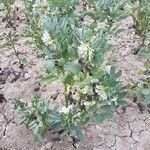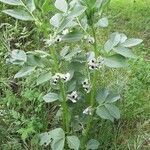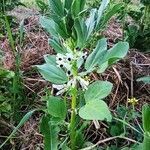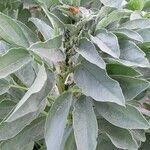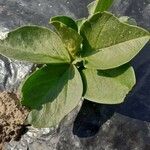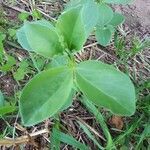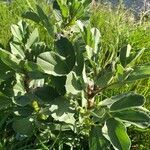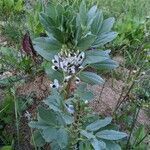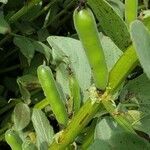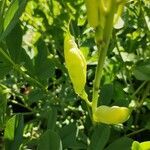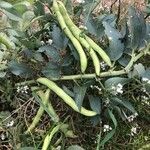Erect annual; stems ± glabrous, squared. Lvs ± glabrous; tendrils 0, the rachis terminated by a short mucro; leaflets in 1-3 pairs, often alternate, elliptic, 40-80 mm long; stipules entire or dentate and with 1, adaxial, basal lobe. Infl. much < lvs, 1-4-(6)-flowered. Peduncle much < fls. Pedicel 2-3 mm long. Calyx somewhat gibbous at base; calyx teeth unequal; lower teeth < tube; upper teeth much < tube. Corolla usually white or tinged reddish purple, with black spots on wings and black stripes, 20-30 mm long; limb of standard ± = or > claw. Pod densely puberulent but becoming sparsely puberulent when mature, brown, few-seeded, up to 200 mm long; seeds ovoid-oblong, compressed, 20-30 mm long; hilum ⅛ of circumference.
Herbs annual, 30-120 cm tall. Stem erect, thick, glabrous. Leaves paripinnate; stipules hastate or triangular-ovate, 10-25 mm, margin slightly toothed; leaflets 1-5-paired, oblong, elliptic, or obovate, 40-60(-100) × 15-40 mm, glabrous, apex mucronate; tendril absent, replaced by a mucro. Flowers 2-4(-6) in axillary fascicles. Calyx campanulate, unequally toothed. Corolla white with purple veins, 20-35 mm; standard constricted at middle, longer than wings; wings longer than keel. Ovary sessile, linear; ovules 2-4(-6). Legume stout, 50-100 × 20-30 mm, tomentose. Seeds 2-4(-6), oblong, compressed, 8-30 mm. Fl. and fr. Mar-Sep. 2n = 12, 14.
Stout erect annual 5–20 dm with 4-angled stems and no tendrils; lfls 2 or 3 pairs, large, ovate or elliptic, 4–10 cm; fls 20–30 mm, mostly white, veined with violet, the wings with a large violet spot; fr 8–20 × 1–3 cm, with 2–4 large seeds; 2n=14. Long cult. in Europe, occasionally cult. in Amer. and rarely escaped.
